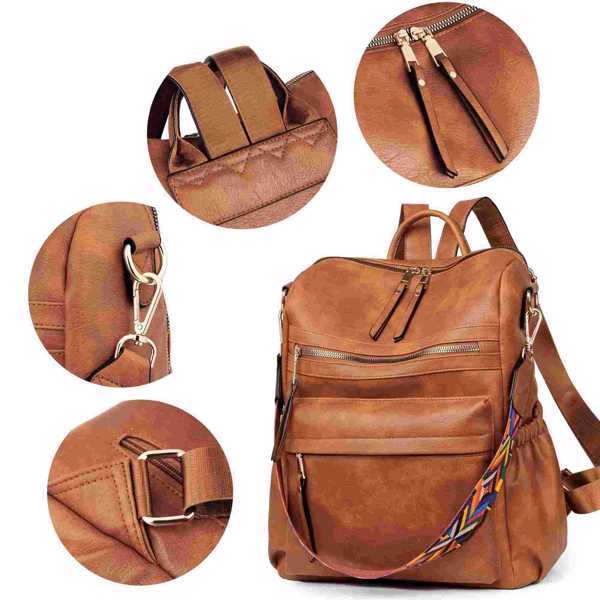
How to care for different handbag materials to prolong their life?
You've invested in a beautiful handbag – congratulations! Now, to truly make it a lasting companion, proper care is absolutely essential. Think of your handbag like a fine car or a cherished piece of jewelry – it needs regular maintenance to stay in top condition and look its best for years to come. As your fashion care expert, I'm here to provide your material-specific handbag care guide, ensuring your beloved bags stand the test of time.
Leather Handbag Care: The Art of Nurturing
Leather, being a natural material, requires a bit more TLC than some synthetics. But the rewards are well worth it – beautifully cared-for leather develops a gorgeous patina and becomes even more characterful over time.
-
Regular Cleaning:
-
Gentle Dusting/Wiping: For everyday maintenance, gently dust your leather bag with a soft, dry cloth or a soft brush to remove surface dirt and debris.
-
Damp Cloth Cleaning (for Minor Dirt): For slightly more stubborn dirt, use a slightly damp (not wet!) cloth. Use distilled water if possible to avoid mineral deposits. Wipe gently in the direction of the grain and allow to air dry completely away from direct heat.
-
Leather Cleaners (for Deeper Cleaning): For deeper cleaning, use a leather cleaner specifically designed for handbags. Always test the cleaner in an inconspicuous area first to ensure it doesn't discolor or damage the leather. Follow the product instructions carefully. Avoid harsh chemicals, solvents, and baby wipes! These can strip the leather's natural oils and cause damage.
-
Saddle Soap (for Certain Leathers - Use with Caution): Saddle soap can be used to deeply clean some types of leather (like smooth, durable leathers), but it can be too harsh for delicate or aniline leathers. Use sparingly and only if you are familiar with saddle soap and your leather type.
-
Conditioning (The Moisture Boost): Leather is skin, and just like our own skin, it needs moisture to prevent drying and cracking. Leather conditioning is crucial to maintain its suppleness and prevent damage.
-
Leather Conditioner: Use a high-quality leather conditioner designed for handbags. Apply a small amount to a soft cloth and gently rub it into the leather in circular motions. Follow the conditioner's instructions regarding application and buffing.
-
Frequency of Conditioning: Conditioning frequency depends on usage and climate. In dry climates or with frequent use, condition every 1-3 months. In humid climates or with less frequent use, condition every 3-6 months. Leather that feels dry or stiff needs conditioning.
-
Patch Test: Always patch test leather conditioner in an inconspicuous area (like the bottom of the bag or inside a pocket) before applying to the entire bag.
-
Rain and Stain Protection: Leather is susceptible to water damage and stains.
-
Leather Protector Sprays: Use a leather protector spray specifically designed for handbags to create a barrier against water and stains. Reapply periodically, especially after cleaning.
-
Avoid Prolonged Rain Exposure: Try to avoid prolonged exposure to heavy rain. If your leather bag gets wet, blot it immediately with a soft, dry cloth and allow it to air dry completely away from direct heat. Never use a hairdryer or place it directly in the sun.
-
Stain Removal (Act Quickly): If you spill something on your leather bag, act quickly! Blot (don't rub) the stain with a clean, damp cloth. For oil-based stains, sprinkle with cornstarch or talcum powder to absorb the oil, then gently brush away after a few hours. For stubborn stains, consider professional leather cleaning.
-
Storage is Key: Proper storage is vital to prevent damage when your leather bag isn't in use.
-
Dust Bag: Always store your leather handbag in a dust bag when not in use. This protects it from dust, scratches, and sunlight.
-
Stuffing (to Maintain Shape): Stuff your handbag with acid-free tissue paper or bubble wrap to help it retain its shape, especially for structured bags. Avoid using newspaper as ink can transfer.
-
Cool, Dry Place: Store your leather handbag in a cool, dry place away from direct sunlight, heat, and humidity. Avoid storing in plastic bags, as leather needs to breathe.
Canvas Handbag Care: Casual and Easy, but Still Important
Canvas handbags are generally more low-maintenance than leather, but some basic care will keep them looking fresh and prolong their life.
-
Spot Cleaning (for Most Stains): Canvas is generally easy to spot clean.
-
Damp Cloth and Mild Soap: For most stains, use a slightly damp cloth with a mild soap (like dish soap or mild laundry detergent) diluted in water. Gently rub the stain in circular motions and then blot with a clean, damp cloth to remove soap residue. Allow to air dry completely.
-
Avoid Harsh Chemicals and Bleach: Avoid harsh chemicals, bleach, or strong detergents, as these can damage the canvas fibers and fade colors.
-
Washing (for Some Canvas Bags - Check Care Label): Some canvas handbags (especially those without leather trim or delicate hardware) can be hand-washed or even machine-washed (on a gentle cycle, cold water). Always check the care label first!
-
Hand Washing: Hand wash in a basin or sink with lukewarm water and mild detergent. Gently agitate the bag and rinse thoroughly with clean water.
-
Machine Washing (Gentle Cycle): If machine washable, place the bag in a mesh laundry bag to protect it and wash on a gentle cycle with cold water and mild detergent.
-
Drying: Always air dry canvas handbags! Avoid machine drying as heat can shrink or damage the canvas and any trim. Lay flat or hang to dry away from direct sunlight.
-
Stain Pre-Treatment (for Tough Stains): For oil-based stains on canvas, try pre-treating with cornstarch or baking soda to absorb the oil before cleaning with soap and water. For ink stains, try blotting gently with rubbing alcohol (test in an inconspicuous area first).
-
Waxed Canvas Care (Specific to Waxed Canvas): Waxed canvas has a water-resistant wax coating.
-
Avoid Washing Waxed Canvas: Avoid fully washing waxed canvas if possible, as this can remove the wax coating. Spot cleaning is preferred.
-
Re-waxing (to Maintain Water Resistance): Over time, the wax coating on waxed canvas can wear down. You can re-wax your canvas bag periodically (every few years, depending on use) using a bar of fabric wax to maintain its water resistance and rugged appearance. Follow wax product instructions.
Nylon Handbag Care: Super Easy and Practical
Nylon handbags are renowned for their practicality and ease of care.
-
Easy Cleaning - Often Machine Washable: Many nylon handbags are incredibly easy to clean, often being machine washable! Always check the care label first, but many nylon bags can be machine washed on a gentle cycle with cold water and mild detergent.
-
Machine Wash in Mesh Bag (Gentle Cycle, Cold Water): Place your nylon bag in a mesh laundry bag to protect it during washing and wash on a gentle cycle with cold water.
-
Hand Washing (Quick and Easy): Nylon is also very easy to hand wash. Simply wash in a sink or basin with lukewarm water and mild soap.
-
Spot Cleaning: For minor dirt or stains, spot cleaning with a damp cloth and mild soap is often sufficient.
-
Drying: Air Dry is Best, Tumble Dry Low (If Allowed): Air drying is generally recommended for nylon handbags. Hang or lay flat to dry away from direct heat. Check the care label, but some nylon bags can be tumble dried on very low heat, but air drying is gentler and safer for longevity.
-
Stain Removal (Easy for Nylon): Nylon is generally very stain-resistant. Most stains can be easily removed with mild soap and water. For tougher stains, try a stain remover designed for synthetic fabrics, but always test in an inconspicuous area first.
Vegan Leather Handbag Care: Material-Specific Approach
Vegan leather care depends on the type of vegan leather (PU, plant-based, etc.). Always check the manufacturer's care instructions if available.
-
PU Vegan Leather Care (Most Common Synthetic):
-
Gentle Wiping with Damp Cloth: For general cleaning, wipe PU vegan leather with a slightly damp cloth (distilled water is best) and mild soap if needed.
-
Avoid Harsh Chemicals and Solvents: Avoid harsh chemicals, solvents, alcohol-based cleaners, or baby wipes, as these can damage the PU coating.
-
Mild Soap and Water for Stains: For stains, try a mild soap (like dish soap) diluted in water. Gently rub the stain and then blot with a clean, damp cloth.
-
Conditioning (Optional, but for Specific PU Conditioners): Some PU vegan leathers benefit from conditioning to maintain suppleness and prevent cracking. Use a conditioner specifically designed for PU leather or synthetic leather. Patch test first.
-
Plant-Based Vegan Leather Care (Piñatex, Mushroom Leather, etc.): Care for plant-based vegan leathers varies depending on the specific material.
-
Follow Manufacturer's Instructions: Always prioritize the manufacturer's care instructions provided with the handbag.
-
Gentle Cleaning: Generally, gentle cleaning with a damp cloth and mild soap (if necessary) is recommended.
-
Avoid Harsh Chemicals: Avoid harsh chemicals, solvents, and alcohol-based cleaners.
-
Conditioning (May or May Not Be Recommended): Conditioning needs vary greatly with plant-based vegan leathers. Some may benefit from specific conditioners, while others may not require it or even be damaged by it. Consult manufacturer instructions.
General Handbag Care Tips for ALL Materials:
-
Rotate Your Handbags: Don't use the same handbag every single day. Rotating your bags allows them to "rest" and reduces wear and tear.
-
Empty Your Bag Regularly: Don't overload your handbag with unnecessary items. Overloading puts extra strain on seams, straps, and closures. Empty your bag regularly and declutter.
-
Be Mindful of Surfaces: Be mindful of where you place your handbag. Avoid placing it on rough or dirty surfaces that can scratch or stain it. Use handbag hooks or place it on clean surfaces when possible.
-
Professional Cleaning (for Stubborn Issues): For stubborn stains, significant damage, or for delicate handbags, consider professional handbag cleaning and repair services. They have specialized tools and expertise to handle various materials and issues.
By implementing these material-specific care tips and general handbag maintenance practices, you'll not only keep your handbags looking their best but also significantly extend their lifespan. A little care goes a long way in preserving your cherished handbag collection!






Leave a comment
This site is protected by hCaptcha and the hCaptcha Privacy Policy and Terms of Service apply.